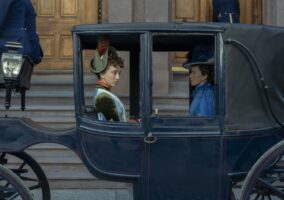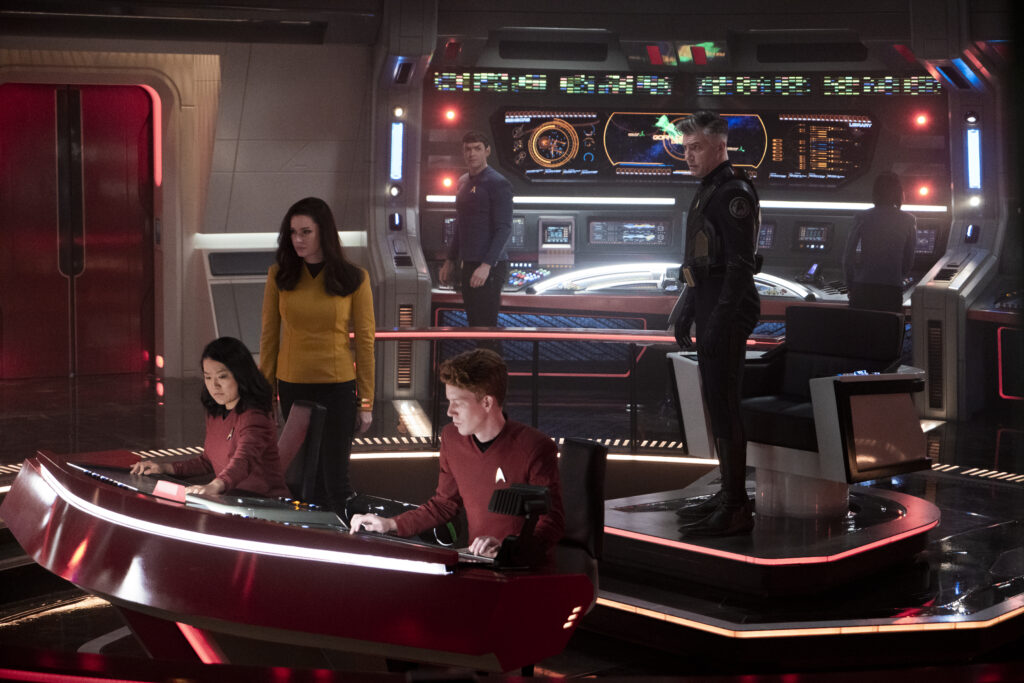
Let’s kick this one off with a little bit of controversy, shall we? Tom, who’s the mega-nerd guiding this review along, has seen roughly 95% of all live action Star Trek series and movies (in many cases several times over, in some cases to the point of being able to nerdily quote whole scenes) and he’s prepared to call Star Trek: Strange New Worlds the most well-written, well-cast, well-acted, and stunningly art-directed Star Trek series ever. You heard him. Note that we didn’t use the word “best” here. Because Star Trek is such a long-running, and in many respects, groundbreaking franchise, each entry has to be taken in the context of its time. So, for instance, the Original Series may not always have had the best acting, and certainly the art direction and special effects didn’t stand the test of time, nor did its gender politics age well, but there’s a damn good argument that it’s still the best of Trek, if only by virtue of being so creative, with such a legendary cast that it spawned the entire universe that followed it. Next Generation and Deep Space Nine also have to be considered for “best Trek” status; the former for its iconic cast anchored by the best actor the franchise ever had, the latter for pushing the franchise into more mature areas and sophisticated styles of storytelling. But SNW managed something no previous Trek series ever has: it came out of the gate strong, knowing exactly what it was, who the characters were, and where it wanted to go. Every other series in the franchise took a little time getting its space legs, so to speak. Some of them even took several seasons to figure themselves out (back when seasons had 20+ episodes). Just to take the controversy a little further, Tom turned to Lorenzo after last week’s genre-busting, jaw-dropping musical episode “Subspace Rhapsody” and blurted out “That is easily a Top Ten all-time Star Trek episode.”
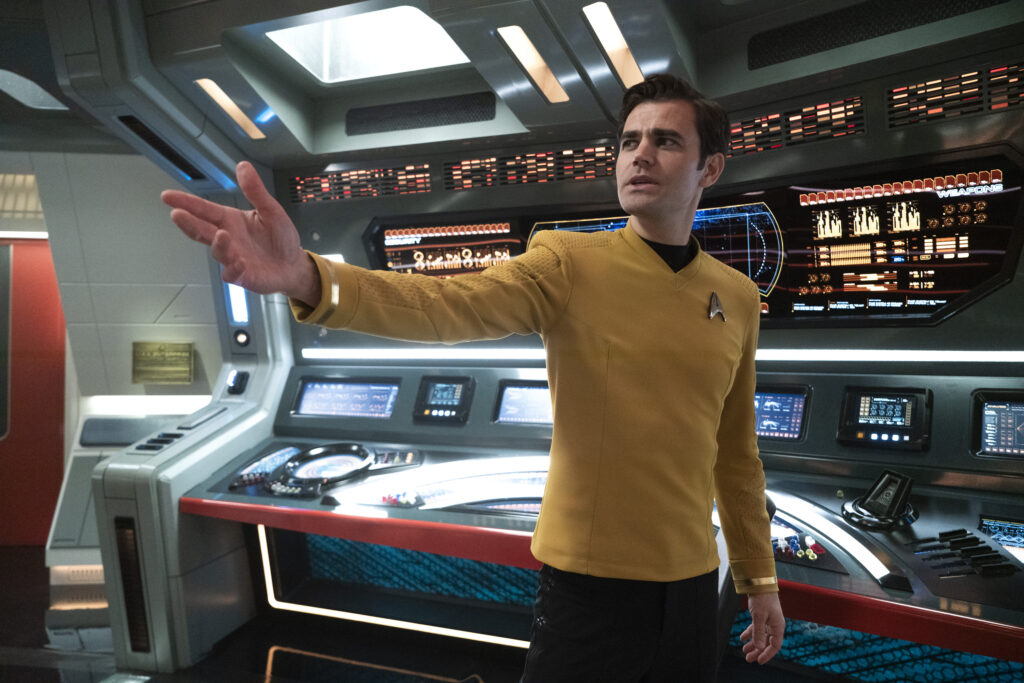
Is it a perfect show? Not at all. It suffers the same problem all prequels do: the lack of tension regarding the fates of several prominent characters. It also occasionally has some plotting issues, is a little too focused on looking backwards at the franchise’s mythos, and plays fast and loose with that very mythos even as it demonstrates a somewhat rigid devotion to it. To be fair, that last criticism isn’t one that bothers us too much. In a franchise with over 500 hours of screentime spread out over nearly 60 years, representing the work of literally thousands of actors, writers, producers, directors, production and costume designers, anyone who expects a consistent continuity is being a bit ridiculous. We don’t mind if they shift the dates of the Eugenics Wars, mutate the Gorn into human-eating xenomorphs, or even have iconic characters show up just so we can point at them in recognition. We don’t mind that the ship and the technology look far more advanced than the way they were depicted in 1966. Of course they do. It would be completely unrealistic to expect modern audiences to take a mid-sixties, low budget sci-fi aesthetic seriously. Besides, the design nerds in us love how well they’ve interpreted that Trek-ian mid-century style. The hairstyles are a bit more elaborate and lacquered than you’d expect for a show in 2023, the officers’ quarters and forward lounge are swanky as hell, giving off a sort of “Mad Men in Space” vibe, and the mini-skirts have been cleverly tweaked as tunics over leggings.
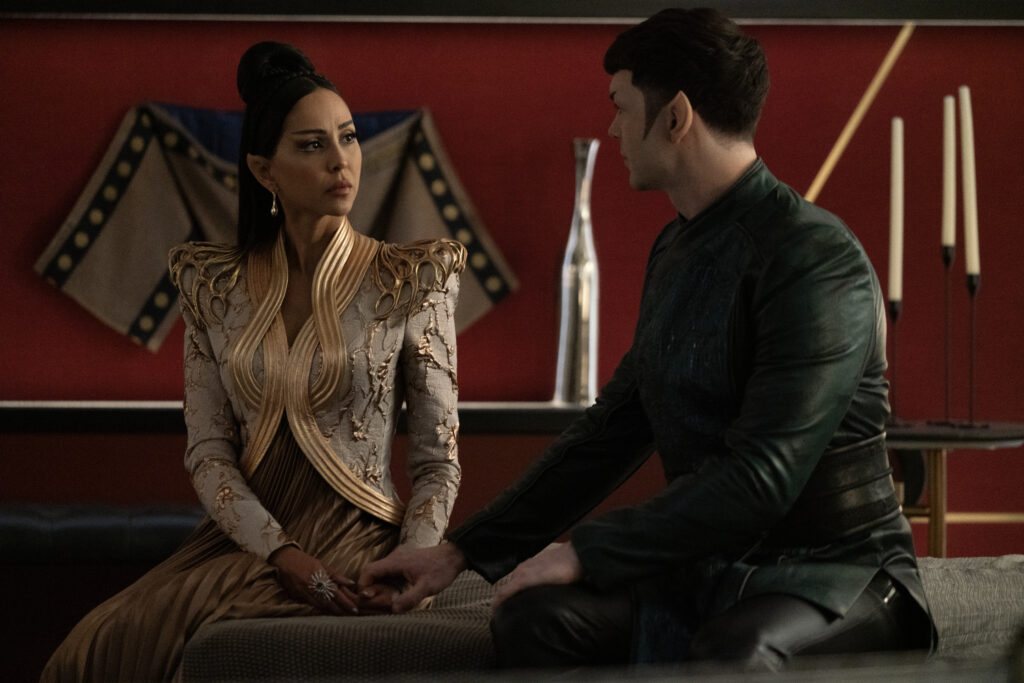
Still, there are times when the show feels like it’s coloring inside some rather tight lines so that every character from the Original Series starts to feel a bit… over-explained. Uhura has a tragic family past that makes her put up walls around her but also has her seeking connections through her communication skills. Chapel and Spock have a much more complicated history than the Original Series ever hinted at, as did T’Pring and Spock. Pike knew his final fate a decade before it happened. M’Benga was a morally compromised badass with PTSD. The Kirk brothers had a lifelong rivalry that their father encouraged. Number One hid her true nature from everyone her entire life, knowing it would destroy everything she’s ever accomplished if it got out. These aren’t bad choices, necessarily. Kirk and Spock aside, most of the legacy characters the show has chosen to focus on have rather sketchy or downright blank back stories. It’s actually kind of fun to learn more about Sam Kirk or to explore the origins of T’Pring’s animosity toward Spock. But it can sometimes feel like the show is too focused on nostalgic reinventions. Original characters like Carol Kane’s Pelia or Melissa Navia’s Ortegas remain some of the least-developed on the show. To be fair, Christina Chong’s La’An Noonien-Singh is one of the best characters on the show, but even then, the focus of her story is on how it ties into that of the franchise’s most legendary villain.
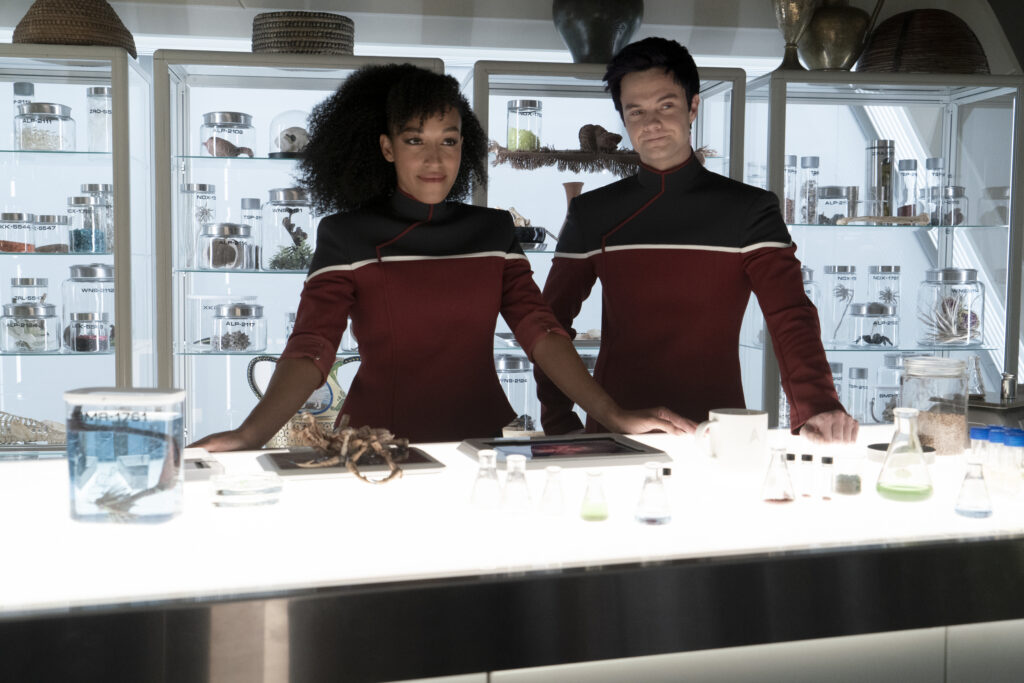
But Strange New Worlds is a show that understands something fundamental about Star Trek; something that the first two seasons of Picard and most of Discovery didn’t quite realize: Star Trek is supposed to be fun. That doesn’t mean it necessarily has to be lighthearted in the way that Lower Decks is, but the stories and the characters should be entertaining to watch. Something else SNW managed from the beginning that Discovery and Picard took several seasons to understand: it’s only fun to watch if you give them people you want to watch together. In other words, they didn’t just establish great characters with sometimes complicated back stories, they put the work in on establishing some nuanced and rewarding relationships. M’Benga and Chapel were MASH unit buddies who saw some shit together during the Klingon war. Una and La’An have a sisterly relationship because the former saved her life and sponsored her Starfleet application. Pike and Una are the mom and dad of the ship, deeply devoted to each other and upholding their ideals, able to confide in each other, sporting some of the best hair in Star Trek history. Spock and Chapel are hot for each other but too different to make it work – and for a nice change of pace, it has less to do with his alien aloofness and more to do with her trauma and ambition. The women of the command crew (and there are an impressive number of well-developed ones, even for Star Trek) have an easy bond that is neither over-explained or over-written. It just is. When M’Benga and Ortegas are expressing concern over Nurse Chapel’s fate in the season finale, Ortegas imitates her telling them to get back to work. “That’s a pretty good Christine,” M’Benga notes. “She does a better me,” Ortegas responds. That stuff. That’s what makes this show so good.
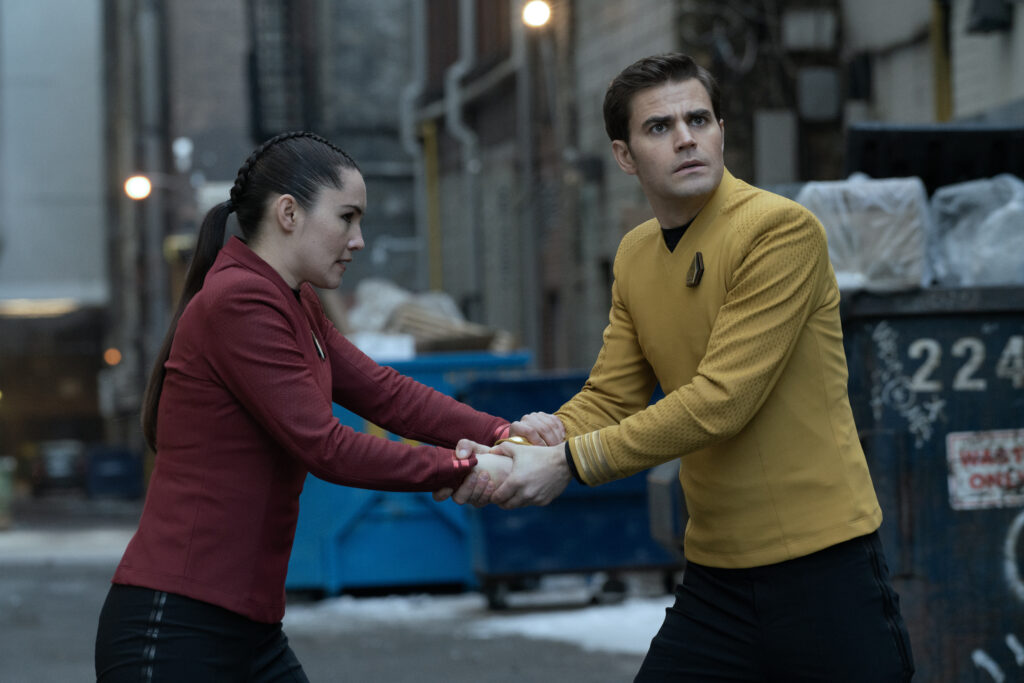
More than that, Strange New Worlds is a Star Trek show that understands what made a classic season of Trek so entertaining and is willing to take formal and narrative risks in a manner so confident it’s almost a little disarming. The creators behind SNW (there are too many to list, but at least some credit should go to season 2 showrunners Akiva Goldsman and Henry Alonso Myers) know the value of a good courtroom drama episode that wrestles with larger questions of personhood or prejudice, or a Vulcan comedy of manners, or a tragic time travel tale, or a damn good cliffhanger as a captain is faced with an impossible situation. It checks off all of those Trek boxes, but also takes big swings by incorporating animated characters or pulling off an entire musical episode. While we can’t say every episode of season 2 was an all-timer, the last four episodes delivered one new classic after another. “These Old Scientists” introduced Lower Decks‘ Boimler and Mariner (Jack Quaid and Tawny Newsome, embodying their own voice work in real life — and perfectly, we might add) in an episode that was whimsically lighthearted, but also paid attention to Pike’s knowledge of his fate and set the stage for Chapel’s breakup with Spock. After that came “Under the Cloak of War,” which gave us fantastic character arcs for Chapel and M’Benga, fleshed out a little more of the fallout from Discovery’s Klingon War, and wrestled with questions of trauma and peacetime reconciliations. Following that came the truly astonishing “Subspace Rhapsody.” As Tom said to Lorenzo during Christina Chong’s amazing “How Would That Feel” scene, “Jesus Christ, I had no idea they were going to go so hard on this idea.” They delivered a full-on Broadway musical version of Star Trek which didn’t sacrifice a single thing from either genre. The songs were either charmingly cute or full-on bangers (Celia Rose Gooding’s “Keep Us Connected” deserves a shoutout here, but for our money, Jess Bush’s “I’m Ready” was the most fun to watch). Cleverly, the songs used exactly the kind of language you’d hear in a typical Star Trek episode (“Status Report“), but also stayed true to several character arcs and relationships. We honestly think it’s an episode that deserves every kind of awards nomination it’s eligible for, but we suspect it won’t get the attention it deserves. And finally, there was “Hegemony,” ending on a cliffhanger that couldn’t have been a more direct callback to a classic scene in Trek lore without having Pike inexplicably intone “Mr. Worf… fire.” Did they make Captain Batel’s fate a little too obvious? Do we actually need Scotty in the story at this point? Is it a little silly that Chapel was the only person to survive the Cayuga attack? Does it seem like Pike made a bad situation exponentially worse, which is something he has a tendency to do? Yes to all of it. It still rocked as a finale, paying off a lot of season-long arcs and character work, raising the stakes (we might not have fretted too much over the legacy characters, but we’re more than a bit concerned about the fates of La’An, Ortegas, and Batel) and keeping the tension high. It was great work and we’re just sorry it’s going to take so long for us to find out what happens next.
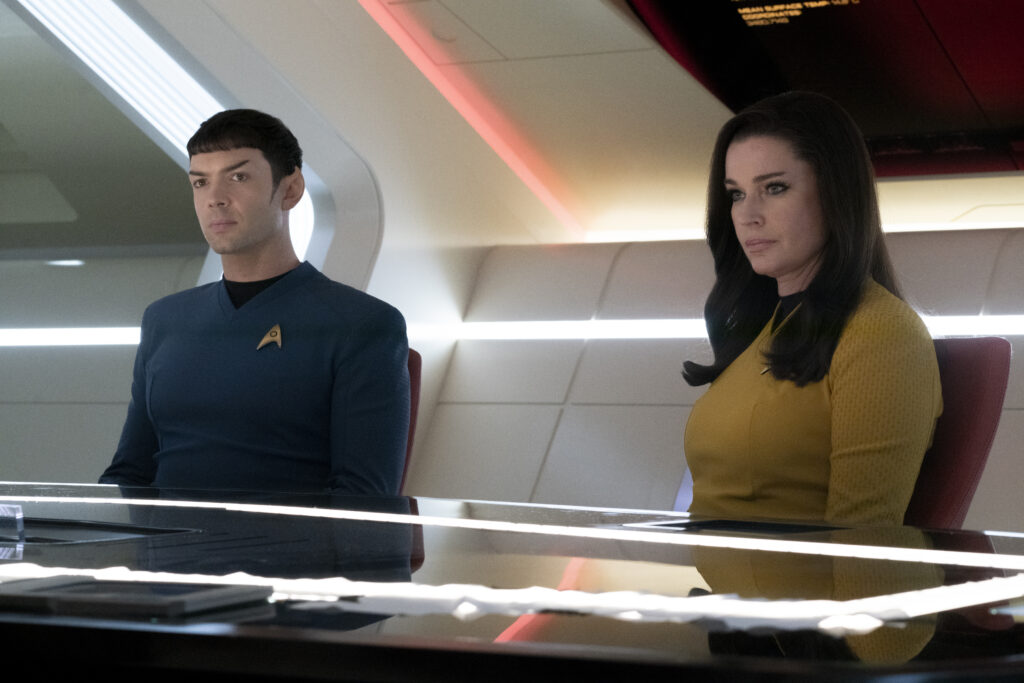
If you asked us what kind of Star Trek show we’d most like to see, it’s the proposed Star Trek: Legacy, which would take place in a more or less post-Picard universe. We want a more forward-looking Star Trek that builds on the decades of stories in its history rather than a backwards-looking version that fills in blanks no one was really asking to be filled in. Even so, until that day comes (and there is no guarantee we’ll be happy with the results when it does), we’re just thrilled to have such a well-executed, entertaining and downright fun show that feels like all of the good things about Star Trek got distilled to their essence.
EUPHORIA Star Sydney Sweeney in Alexander McQueen at the 2023 VARIETY Power of Young Hollywood Event: IN or OUT? Next Post:
American and British VOGUEs Share September 2023 Cover: The Super Models
Please review our Community Guidelines before posting a comment. Thank you!

